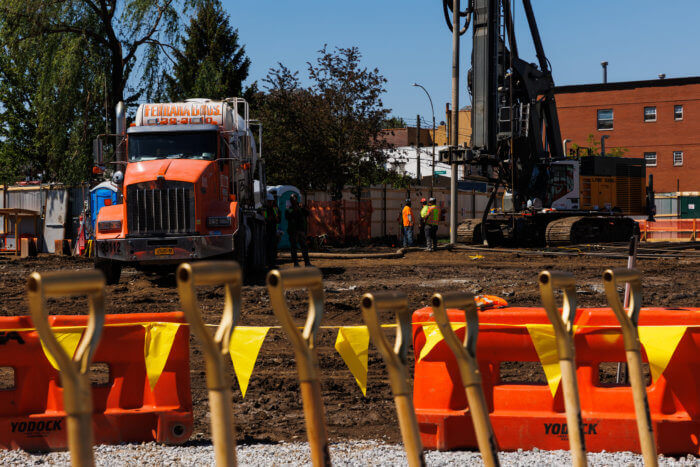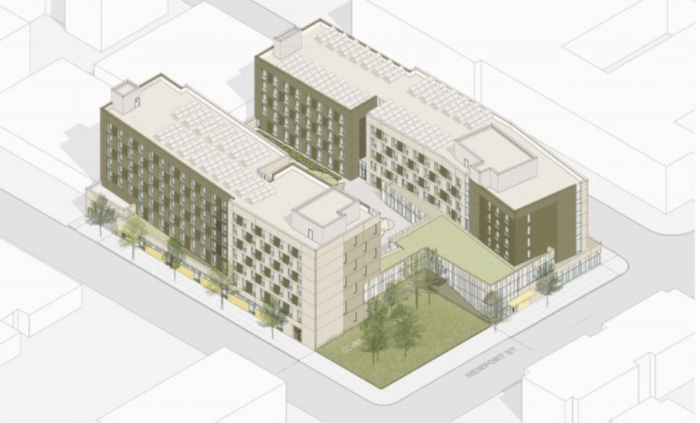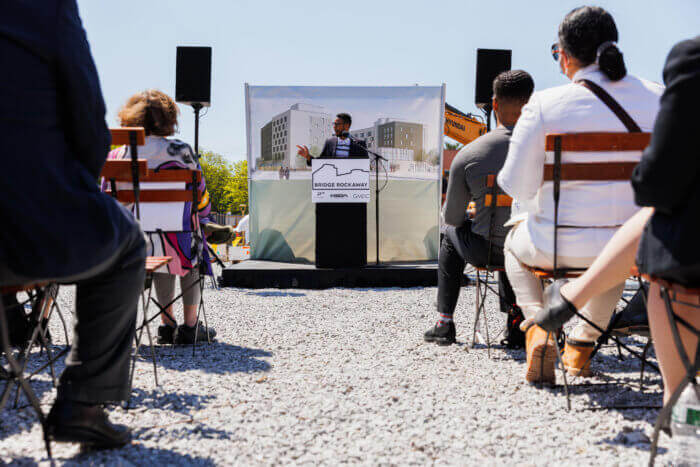Pols Kick Off Construction of Affordable Housing and Light Manufacturing Complex in Brownsville
Bridge Rockaway, an unusual kind of mixed-use affordable housing development, is in the works in Brownsville, bringing 174 affordable apartments and nearly 40,0000 square feet of light manufacturing space to the neighborhood.

Local officials, developers and community members hold a ground breaking ceremony for the Bridge Rockaway development in Brownsville in 2022. Photo by Paul Frangipane
Bridge Rockaway, an unusual kind of mixed-use affordable housing development, is in the works in Brownsville, bringing 174 affordable apartments and nearly 40,0000 square feet of light manufacturing space to the neighborhood.
The $118 million project, part of Governor Kathy Hochul’s plan for housing reform, will include 87 permanent supportive housing units for formerly and chronically homeless New Yorkers and, when finished, is expected to create 35 new industrial jobs and 20 jobs in the residential portion of the building.
“We as New Yorkers, unfortunately, are too familiar with the crisis of street homelessness currently facing the city,” said Susan Wiviott, CEO of The Bridge, the social services organization that will manage the apartments. “It’s a very difficult situation right now for New York, and it’s actually a real tragedy for those people experiencing it.”

“But about two years from now, right now, right here, where we’re all sitting, there will be a very large building that will provide 87 units of supportive housing to people very similar to those living on the streets today,” Wiviott said.
The building at 803 Rockaway Avenue is expected to be finished and occupied by 2025, and residents will have access to support and social services provided by The Bridge, who currently provide mental health and substance abuse services, job training and housing support to more than 4,000 people each year, according to their website. The organization operates 24 residential buildings, including a Safe Haven shelter in the Bronx and transitional housing developments.
About 35 units will be reserved for seniors and veterans in need of supportive services, according to Hochul’s office, and services for those units will be funded by the Empire State Supportive Housing Initiative. More than 50 additional apartments are earmarked for “chronically homeless” tenants, with services funded by the NYC 15/15 Congregate Supportive Housing Services Program.
The rest of the apartments will be aimed at households making between 30 and 70 percent of the Area Median Income, or about $37,360 to $93,000 per year for families ranging in size from one to four people.
While mixed-use buildings are a mainstay in new development, the ground floor of most of those developments is reserved for retail and commercial space. Reserving space for manufacturing is important for the health of the local community’s economy and for the city and state at large, said Brooklyn Borough President Antonio Reynoso at the Tuesday morning ribbon cutting.
“The way we do manufacturing in the city of New York doesn’t need to go away. If Covid taught us anything, it is that we need to start thinking about being sustainable, self sustainable,” the beep said. “In moments of crisis not to have to depend on other countries, on other states and being able to produce stuff, to manufacture stuff.”

Bridge Rockaway is “a gamble,” Reynoso said, an experiment in new kinds of development. The former council member told Brooklyn Paper earlier this month that he’d like to see more “comprehensive” development in Brooklyn, with each community’s needs and desires taken into account.
“It’s going to be a test case and I guarantee in a couple of years it will be the model for how we do development in and around manufacturing in the future,” he said.
About 10 percent of Brooklyn Community District 16, which includes Ocean Hill and Brownsville, is zoned for manufacturing. While the city’s Department of Housing Preservation and Development was developing its Brownsville Plan, residents said they wanted to see more connections to jobs and job training, said HPD Commissioner Adolfo Carrión Jr. in a release.
“Bridge Rockaway does just that. It brings jobs and affordable housing to the Brownsville community,” Carrión said.
Dan Garodnick, director of the city’s Department of City Planning, praised the partnership between the city and the businesses that will build and operate the development.
“I’m happy to see this unique project move forward, one that thoughtfully and safely combines deeply affordable housing and nonprofit industrial space within the same building,” Garodnick said in a statement. “Innovative public-private partnerships like this help push the boundaries on ways to connect New Yorkers to affordable homes and economic opportunity at once.”

Ten to 12 local businesses will run small-scale manufacturing operations on Bridge Rockaway’s ground floor, which will be operated by the Greenpoint Manufacturing and Design Center.
“It will expand new opportunities for local residents in Brownsville,” said RuthAnne Visnaukas, commissioner of the state’s Homes and Community Renewal Division. “It will drive additional investment and economic activity and we think it will just become this incredible epicenter for small business and light manufacturing, just as has been done in so many other neighborhoods across Brooklyn.”
The project’s general contractor, Mega Contracting, is planning to partner with Building Skills NY and HireNYC to hire locally for the duration of construction. Once finished, Bridge Rockaway will also feature more than 11,000 feet of open green space, a sorely needed addition to the neighborhood.
“Brownsville was no stranger to the devastation caused by the Covid pandemic and one of the best ways that we can overcome lost wages and lost jobs and the effects of inflation is making sure that people have access to affordable rents,” Visnaukas said.
Editor’s note: A version of this story originally ran in Brooklyn Paper. Click here to see the original story.
Related Stories
- Flatbush Affordable Housing, Revamped Caribbean Marketplace Celebrate Grand Opening
- Housing Lottery Opens for Adjmi-Designed Apartments at Puccio Marble Yard in ‘Burg
- Affordable Housing Lottery Still Open as Conversion of Downtown Brooklyn YWCA Wraps
Email tips@brownstoner.com with further comments, questions or tips. Follow Brownstoner on Twitter and Instagram, and like us on Facebook.





What's Your Take? Leave a Comment